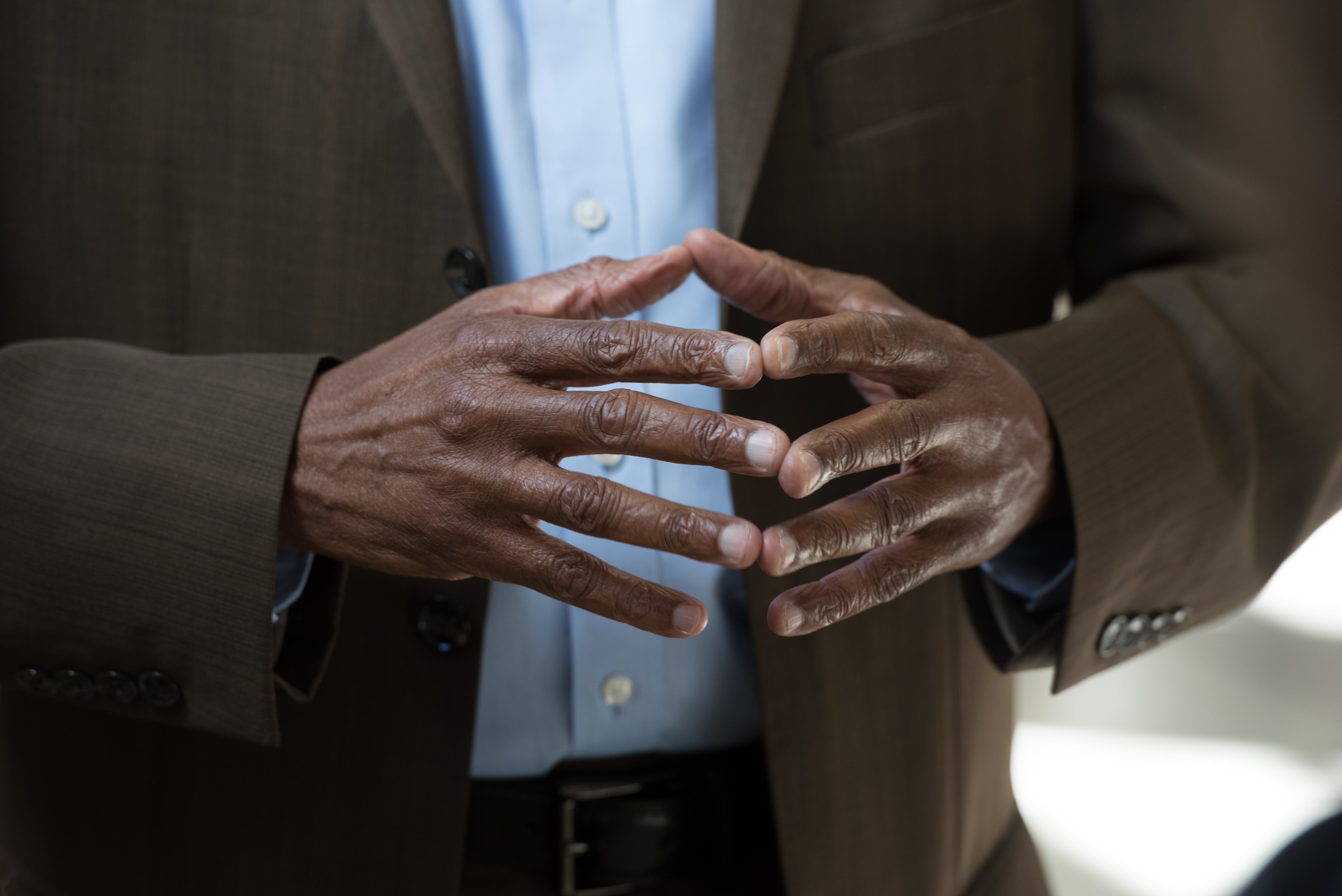Published on nola.com on January 10, 2017
By Jonathan Bullington and Richard A. Webster
Sitting at a short blue table in a kid-sized yellow chair, 8-year-old Jonathan Guillory Jr. colors Care Bears drawings, his head tilted in concentration. Across the table, his father, Jonathan Guillory Sr., watches as daughter Ja’layna, 10, helps younger sister Gynesis, 4, stay within the lines.
One of Ja’layna’s favorite parts of these Sunday mornings is getting to play Battleship with her dad – even though, she says with a grin, he usually wins. She’s also excited to eat a baked potato loaded with broccoli and cheese and bacon bits, sold by one of the vendors in the kitchen along the far wall.
People weave between the tables at the center of the tile-floored room, most occupied by loved ones eating, playing cards or holding hands. The din of conversation is periodically broken by announcements over the loudspeakers or the unmistakable clang of the double metal doors closing: a stark reminder that this is not a church basement.
This is Sunday morning at Angola, Louisiana’s notorious maximum-security prison. As it will be for many inmate families, the sights and sounds of the prison’s main visiting room will forever be the backdrop for much of the Guillory children’s interaction with their father, who is serving a life sentence for murder.
And to go without it would be almost unimaginable, the kids say.
“I would be very sad,” Ja’layna said. “And I might cry every day because I want to hug and kiss my daddy.”
Ja’layna and her siblings are among an estimated 5.1 million children nationwide whose lives are molded by parental incarceration – 94,000 of them in Louisiana. Child welfare experts say in-person visits play a crucial role in shielding those children from the emotional and physical toll of their parents’ imprisonment.
“Kids express they want to stay connected to their parents,” said Melissa Tanis, a communications assistant with Osborne Association, a New York-based nonprofit organization that focuses on children and families of incarcerated parents. “It can be beneficial to them to see and touch their parents and to know their parents are safe. It can increase performance at school and lessen emotional stress and emotional problems.”
Studies show that regular visits from family reduce recidivism, chipping away at prison overcrowding and easing the burden on the criminal justice system.
But keeping children connected to their mothers and fathers behind bars is not easy. Prison visits can be long and expensive journeys made nearly impossible for those without a vehicle, given the almost nonexistent public transportation options to and from Louisiana prisons.
And for families of inmates inside one of the state’s largest jails, the Orleans Justice Center, in-person visits have been eliminated.
“Contact with loved ones on the outside is extremely important for prisoners who are locked up,” said Katie Schwartzmann, co-director of the Roderick and Solange MacArthur Justice Center, the nonprofit law firm that represented inmates in a class-action lawsuit that led to a federal consent decree at the Orleans Parish prison.
“Family and friends are the source of hope and support in making positive life choices.”
About 8 percent of Louisiana Department of Corrections inmates, some 2,800, are from New Orleans, state figures show. There are seven state-operated prisons and two privately run prisons. Six of those nine facilities are more than 100 miles from the city. The farthest, David Wade Correctional Center in Homer, is a 5 1/2-hour drive across more than 300 miles.
Inmate assignments are based on custody classification and space availability, among other factors.
“While DOC would like to make assignments with only geographical considerations in mind, it is not possible to do this based on the demand for beds in various areas of the state,” said DOC spokesman Ken Pastorick. “As such, offenders are placed in locations that best meet their needs and the space needs of the department.”
Corey Ladd, who is serving a 17-year sentence for marijuana possession, his third felony drug conviction, was being held at Elayn Hunt Correctional Center in St. Gabriel, about an hour from his family’s home in Kenner. He was assigned there because of its proximity to his daughter, now 4.
Ladd’s parents would bring his daughter on prison visits at least once a month. That all changed in July. That’s when authorities transferred him to Allen Correctional Center in Kinder, a three-hour drive from Kenner.
Ladd’s parents said they’re unable to visit him now – the distance is too great, given their physical disabilities.
“He would have visitors to feel like he’s part of a family,” said his mother, Lisa Ladd, 52. “That’s what they tell you: ‘Support him, support him.’ Well then, why would you move him so far away?”
The sun had yet to rise when the Guillory children packed into grandparents Caleb and Deanne Paster’s car and set out across south Louisiana to Angola.
The drive is 181 miles each way. And it’s expensive. Caleb, 59, a security guard at an oil refinery, and Deanne, 48, a car saleswoman, estimate they’ve spent close to $5,000 in the last year making sure the kids can see their father.
“It’s an expense, it really is,” Deanne Paster said, adding that it is further complicated now that she is acting as caregiver to her ailing mother.
But, she said, it’s a price they must pay.
“These are his babies. He took care of those kids before he got here, and I want to make sure it’s continued while he’s here, until he comes home,” Deanne Paster says. “I make sure they’re here so he doesn’t miss any part of their lives. Nobody’s going to take that from him.”
The Pasters say they try to take their grandkids at least once a month, twice if they can afford it. Even in a two-income household, they can’t always make that second trip.
Children of Louisiana’s incarcerated parents are more likely to grow up in poverty than children whose parents are not in prison, studies suggest. After a parent is locked up, more than 65 percent of families can no longer afford their basic needs – rent, utilities, food and medical care – forcing them to become more reliant on government programs and at greater risk of homelessness, according to a report from the Annie E. Casey Foundation, a Baltimore-based nonprofit focused on helping disadvantaged children.
Use of a car is not always an option for families of the incarcerated, leaving them with almost no way to visit their loved ones in prison.
Louisiana does not publicly fund transportation to prisons. New York state once used prison phone surcharges to pay for contracted bus service to its prisons, but the service was cut in 2011, in part because of budgetary savings ($1.5 million) and a push toward video visits.
Nonprofit organizations, like the Osborne Association, have tried to fill the need by organizing periodic bus trips.
“It’s hard to do them regularly, and only so many children have access,” said Allison Hollihan, senior policy manager for Osborne’s New York Initiative for Children of Incarcerated Parents.
Louisiana is among a handful of states where bus trips are offered by the nonprofit sector. Cornerstone Builders, a Catholic Charities Archdiocese of New Orleans program, provides free bus rides at least once a month to four different prisons.
The service costs Cornerstone Builders roughly $30,000 a year, said assistant director Leo Jackson. The money comes mainly from the annual NOLA to Angola fundraiser bike ride, and a grant from Jefferson Parish Sheriff Newell Normand’s office.
Normand said the bus project is among several initiatives his office supports, with the goal of keeping people from returning to prison upon their release.
“Our goal is to reconnect them with family, to get them jobs and to reconnect them to their church in some way, so they can experience the high of those successes as opposed to facing ‘no’ constantly (and) not reconnecting with their family,” he said. “These folks come back to our community, and our community is what matters.”
Most of the bus passengers are single parents, Jackson said, mothers and grandmothers whose only other option was word-of-mouth ridesharing with other inmate families – usually for a fee.
“They don’t make very much money,” he said. “They have a lot of expenses.”
Visits, he said, are “another bill added.”
Jackson said the idea for the bus rides came partly from his own experience as an incarcerated parent. Jackson spent a little more than three decades behind bars before former Gov. Kathleen Blanco pardoned him in 2006.
A year later, remembering how important family visits were for him and his fellow inmates, Jackson organized the first free bus ride.
“It was not just a privilege that you could do or do without. It’s an important service that creates stability in the prison,” Jackson said. “It helps inmates build expectations. Every month they’re looking forward to seeing their family … they want to be out. They don’t want to be locked up not being able to see their family.”
Jonathan Guillory Sr., 30, has been behind bars since his 2015 conviction for second-degree murder in the 2014 fatal shooting of his girlfriend’s stepfather at Guillory’s home – a shooting that Guillory maintained during his trial was in self-defense.
His family’s visits to Angola are “like having somebody give you air,” he said.
“When they leave it’s like they take the air from you,” he said. “Just to know that I can’t be with them every day, it’s just hard.”
Prison officials, too, see the benefits of in-person visits. Private prison operator Corrections Corporation of America states on its website that in-person visits improve inmate morale and encourage good behavior.
An Urban Institute survey of former Maryland prisoners credited strong family ties with a greater likelihood of employment and lower chance of drug use upon release. A 2011 study from the Minnesota Department of Corrections looked at 16,000-plus former inmates and concluded that visits played a significant role in reducing the risk of recidivism.
“The findings suggest that revising prison visitation policies to make them more ‘visitor friendly’ could yield public safety benefits by helping offenders establish a continuum of social support from prison to the community,” the study reads.
Families of Louisiana state inmates must commit themselves to following three pages of guidelines: what visitors can and cannot bring, can and cannot wear. Visitors must fill out an application and undergo a background check. The process typically takes up to 30 days, but an inmate’s immediate family members are allowed to visit during the approval process.
Visits at most facilities are typically offered on weekends, and can last up to three hours, equal in some cases to the time spent in the car. Some visits can extend longer for special circumstances, prison officials said.
Prisons and jails across the country are looking to video – similar to Skype or Apple FaceTime – as a visiting option. There are benefits, experts say. Video visits allow families to stay connected with incarcerated loved ones when the distance to prison is too far or the expense too great. Prison officials see video as a way to securely monitor visits and to ensure that contraband is not passed to inmates through in-person contact.
Osborne Associates offers video visits at its New York City office, Hollihan said. From a space resembling a living room, stocked with toys and books, children can speak to their parents on a video monitor. In Florida, the state’s Department of Corrections partners with a nonprofit organization to operate a bus that brings terminals for video visits to communities.
Some prison officials are ignoring the benefits of in-person visits, choosing instead to offer only video visits. The decision, which advocates say is short-sighted and damaging to vital family connections, requires inmate families to face the same travel challenges as in-person visits, only to speak with their loved ones via a monitor when they arrive.
Nationwide, more than 500 correctional facilities use some form of video visitation, according to a January 2015 report from Prison Policy Initiative. Seventy-four percent of jails that use video visits have also banned in-person visits, the report found.
Orleans Justice Center is among those facilities. While attorneys are allowed in-person visits with inmates inside the new center, which opened last year, all other visits are done over video from a “visitation center.”
Free to family, video visits expand visitation hours and give family members who were previously excluded from in-person visits because of their own criminal records the option to see and speak with their loved ones, said Philip Stelly, spokesman for Sheriff Marlin Gusman. Additionally, Stelly said, the visitation center “enhances public safety by keeping inmate movement to a minimum and by further reducing the risk of contraband entering the facility.”
Monthly in-person visits are allowed for incarcerated mothers enrolled in the sheriff’s Girl Scouts Beyond Bars program, Stelly said. The eight-month-long program is not open to male inmates, who make up about 89 percent of the Orleans Justice Center’s total population of 1,000 inmates.
Katie Schwartzmann with the MacArthur Justice Center criticized the sheriff’s decision to eliminate regular in-person visits, noting that most people currently housed in Orleans Parish jail are awaiting trial and have not been convicted of any crimes.
“It’s incredibly disappointing that the sheriff chose to build a brand new jail with no opportunity for physical visitation between arrestees and their families,” she said. “Video visitation should be offered in addition to in-person contact visitation, not as a substitute for personalized visitation.”
A 12,000 square-foot space to accommodate in-person family visits has been included as part of plans for a new addition to the Orleans Parish jail. The plans, signed by Gusman and the jail’s independent compliance director Gary Maynard, were submitted last week to the federal judge overseeing the jail’s compliance with a federal consent decree.
“Even though there is a trend nationally to encourage video visitation, for both family and attorney visits, there are still strong preferences for personal visits, and consideration needs to be given to both,” the plan states.
New Orleans Mayor Mitch Landrieu’s administration, which in the past has opposed jail expansion plans, called the recent proposal “reasonable and necessary.”
In Lafourche Parish, video visits are being considered as a feature in a new jail under construction in Thibodaux. But, the parish’s longtime Sheriff Craig Webre said, they would not replace in-person visits, “not as long as I’m sheriff.”
“Sometimes you have to put yourself in someone else’s shoes and recognize the reality of human interaction, what it means to look someone in the eye and to support them during a difficult period in their life,” Webre said. “Despite the horrible things someone has done, you can’t take away the bond.”
A guard walked up to Victoria Williams’ table and quietly told her and her family they had 10 minutes left in their two-hour visit.
Williams’ son Levi Cox, 6, kept his grip tight around his mom’s neck, as it had been since he and his older brother Tristian, 18, and father Jody Cox arrived at Jetson Correctional Center for Youth in Baker. The former juvenile prison has been repurposed as one of two temporary homes for inmates at the Louisiana Correctional Institute for Women, which was damaged by August flooding in St. Gabriel.
The visiting room is small and sparsely decorated with nine white, round tables – six chairs to a table – and a guard’s desk just inside the entrance. There’s a painting of a blue flower on one wall, and a vase holding fake white flowers on a ledge next to the window air conditioner. A “Happy Thanksgiving” banner stretches across the front of the guard’s desk. On the wall above the desk hangs a poster on reporting prison sexual assaults.
The Cox family left their home in Franklinton about 7:30 that November morning, arriving at Jetson about an hour and a half later. A white bus took the family from the prison’s front gate to the visiting building. After signing in with the guard, they walked past a table of microwaves and into the visiting room, where they sat and waited for Williams to be dropped off in her own white bus.
Williams, 41, is a few months into her 10-year sentence for drug possession. Dressed in a powder-blue uniform, she was one of only three inmates in the room when she first arrived. She and her husband held hands while Levi sat in his mother’s lap, his cowboy boots dangling near her shins.
“We try to catch up on things,” Jody Cox, 43, said of their visits. “We forget half of what we’re supposed to say and what we had on our mind when we got here … we’re so excited.”
Though thrilling, the visits are also stressful for Williams. She said she worries the whole time about her family making it safely.
“I know if something was to happen it would be my fault, because I’m here and I put myself here,” she said. “So I’ve hurt them. If anything happened to them I’d blame myself. But when they call my name it’s a relief, because I know they made it.”
The hardest part is leaving. With their two hours set to expire, Williams and her family exchange one last hug, one last goodbye.
“It’s hard,” an emotional Jody Cox says of the moment. “I don’t like to leave. But I know we’ll get to see her soon.”
A guard leads Williams to a smaller area near the main visiting room. She sits alone on a bench, waiting to be taken to a private room to be strip-searched before heading back to her cell.
With tears in her eyes, she looks out the window as a white bus pulls away from the building.






